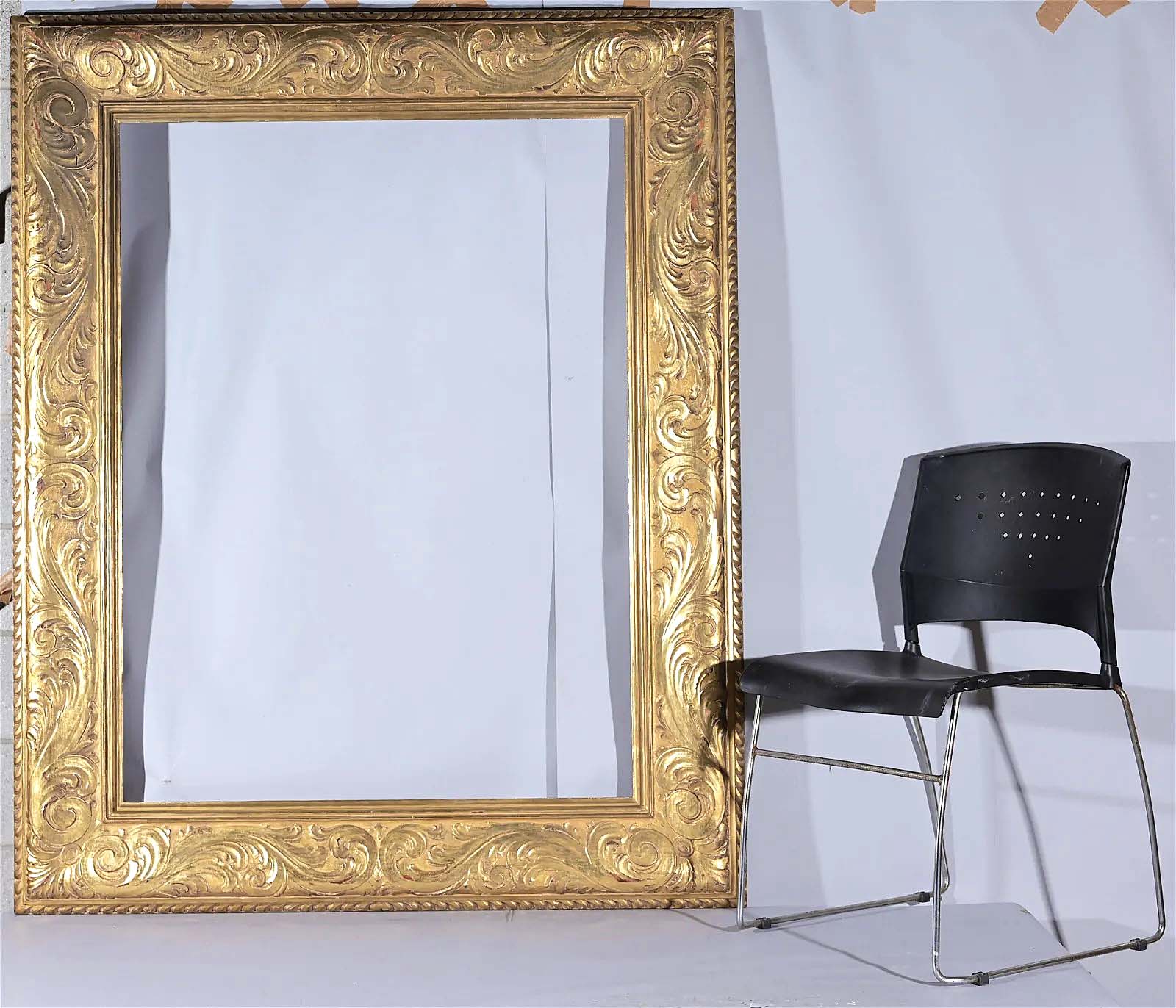
Realizing $32,500, this monumental (79 by 52 inches overall) Stanford White frame set a new world auction record for the highest price of a Stanford White frame at auction. It is considered an exemplary model by White, who was known for reimaging ornamentation in frames and influencing the art of frame-making. Priced in Wilner’s gallery at $1.4 million, Helmuth Stone put a broad estimate of $10/500,000 on it.
Review by Caitlyn “Cat” Snell; Catalog Photos Courtesy Helmuth Stone
SARASOTA, FLA. — Helmuth Stone Gallery’s January 28 sale of the Eli Wilner frame collection proved historic with multiple lots claiming world record sales in their categories. The white glove auction saw all 494 lots sold, bringing in just over $500,000, and the prestigious collection drew the attention of 5,800 bidders who competed for these rarely auctioned lots.
The provenance of these frames, as part of the personal collection of frame maker Eli Wilner, elevated each piece with even the most prototypical example achieving high prices. Austin Helmuth, co-owner of the gallery, expanded on this saying, “[Wilner] took over a period of 40 years to make this collection. This is his encyclopedia of frames…[they] were the gems of his collection.”
This background and the impressive nature of the frames led to the notable prices reached by some. The star of the sale was a large frame constructed by famed architect Stanford White (American, 1853-1906). Made late in his career, the circa early 1900s frame, was once retailed by Wilner’s gallery at $1.4 million, making it the world’s most expensive period frame. Today, it is still setting records as it achieved $32,500 and claimed the title of the highest price for a Stanford White frame ever sold at auction.

The first of the Stanford White Newcomb Macklin frames to break into the top lots was this early 1900s giltwood frame that measured 14 by 11 inches and sold for $5,185 ($1,2/2,500).
More of White’s late-career frames also generated high interest throughout the auction, with many finishing among the highest-earning lots. The second-highest price of the day was another 1900s Stanford White piece. The carved and gilded frame featured tiers of decorative arches that lead into the painting. Going to an art collector in Seattle, Wash., this frame realized $10,400.
A White example featuring continuous leaf-and-berry ornament and acanthus leaf corner decorations saw competitive bidding. Ultimately the Twentieth Century piece went for $8,125. Likewise, a different White frame featuring tiers of braided, dimpled and wavy decorations rose above the price standard for similarly styled pieces and brought $5,185. Another notably large Stanford White frame measuring 52½ by 32½ inches earned $5,000.
Frames from soon after White’s passing also drew interest, with two notable White Newcomb Macklin frames earning high prices. Newcomb Macklin, who had a reputation for high-quality frames, bought the rights to Stanford White’s designs following his death. An early 1900s giltwood frame produced by Newcomb Macklin featured one of White’s designs; with a rich color, wide molding, and a complex design, it sold for $5,185.

An exceptional circa early 1900s Stanford White Newcomb Macklin giltwood frame closed at $4,375 ($2/4,000).
Another White Newcomb Macklin frame, measuring 26½ by 24½ inches, was the only model of its style at sale. Originally retailing for $123,500 in Wilner’s gallery, it brought the seemingly bargain price of $4,375.
While American frames dominated the top lots, some European frames prevailed as well. A Seventeenth Century Italian frame saw a lot of pre-auction interest from bidders in both the United States and overseas. Measuring 18 by 14 inches, the frame was one of only a handful of such early frames from Wilner’s collection. With a darker coloring than many of the gilded pieces and featuring an old label on the reverse, this frame was sold to a buyer in Baton Rouge, La., for $8,125.
Other particularly unique European frames included a French giltwood piece that previously housed “Bust of Christ” by Rembrandt Harmenszoon van Rijn (1606-1669). The frame, which showcased a detailed design with complex flourishes and leaf work, boasted a long provenance evidenced by the many museum and gallery labels affixed to the reverse. This frame exceeded expectations, claiming $3,437.

Originally retailing in Wilner’s gallery for $468,000, this 1909 gilt carved frame from Carrig-Rohane achieved $10,400, setting a new world auction record for a Carrig-Rohane frame ($3/6,000).
More sought-after American frames were seen in an array of competitive Carrig-Rohane pieces. Shining brightest among them was a 1909 Carrig-Rohane gilt frame, which claimed the second world record of this auction when it sold for $9,375 to become the highest-earning Carrig-Rohane frame ever sold at auction. This frame measured 48¼ by 36¼ inches and was in original condition. Helmuth said [it] “was one of the best. We had a couple dealers here call it a ‘super frame’…you’re probably never going to see another frame like it again.” The exceptional condition, its provenance and age helped the success of this piece, which Wilner had retailed for $468,000.
An exceptional 1911 frame boasted a “Carrig-Rohane Tulin-Murphy Co” inscription verso. With a well-balanced use of negative space to detailed patterning, this gilded wooden frame saw fierce competition, before ultimately going to a New York buyer for $6,100. Another Carrig-Rohane frame from 1916 achieved $5,000. According to a label on its verso, it was made specifically for the Vose Gallery in Boston; its standard size and age made it particularly noteworthy for bidders.
Rounding out the high-earning Carrig-Rohane was a large 1905 frame that featured gilt decoration with beautiful flourishes that was also inscribed on the back. Produced only two years after the opening of the Carrig-Rohane shop, its age and workmanship gave this frame strong value. Closing at $5,000 this lot was one of the best priced for the value of the piece.
Helmuth Stone Galleries will conduct an auction of American and European artwork in late March.
All prices include the buyer’s premium as reported by the auction house. For information, www.helmuthstone.com or 941-260-9703.
















